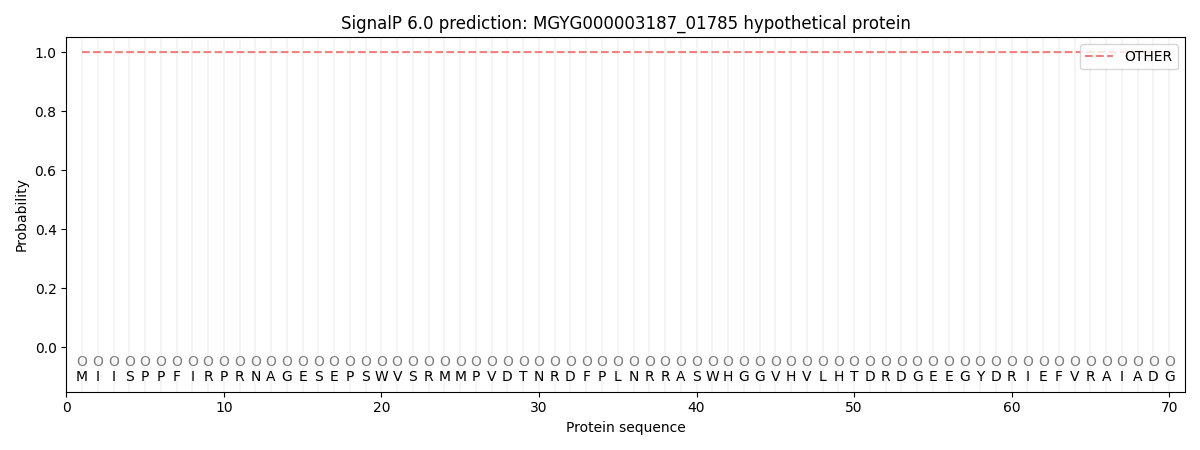You are browsing environment: HUMAN GUT
CAZyme Information: MGYG000003187_01785
You are here: Home > Sequence: MGYG000003187_01785
Basic Information |
Genomic context |
Full Sequence |
Enzyme annotations |
CAZy signature domains |
CDD domains |
CAZyme hits |
PDB hits |
Swiss-Prot hits |
SignalP and Lipop annotations |
TMHMM annotations
Basic Information help
| Species | Leclercia adecarboxylata_C | |||||||||||
|---|---|---|---|---|---|---|---|---|---|---|---|---|
| Lineage | Bacteria; Proteobacteria; Gammaproteobacteria; Enterobacterales; Enterobacteriaceae; Leclercia; Leclercia adecarboxylata_C | |||||||||||
| CAZyme ID | MGYG000003187_01785 | |||||||||||
| CAZy Family | GH0 | |||||||||||
| CAZyme Description | hypothetical protein | |||||||||||
| CAZyme Property |
|
|||||||||||
| Genome Property |
|
|||||||||||
| Gene Location | Start: 365327; End: 367588 Strand: - | |||||||||||
CDD Domains download full data without filtering help
| Cdd ID | Domain | E-Value | qStart | qEnd | sStart | sEnd | Domain Description |
|---|---|---|---|---|---|---|---|
| cd12797 | M23_peptidase | 2.67e-06 | 64 | 159 | 14 | 85 | M23 family metallopeptidase, also known as beta-lytic metallopeptidase, and similar proteins. This model describes the metallopeptidase M23 family, which includes beta-lytic metallopeptidase and lysostaphin. Members of this family are zinc endopeptidases that lyse bacterial cell wall peptidoglycans; they cleave either the N-acylmuramoyl-Ala bond between the cell wall peptidoglycan and the cross-linking peptide (e.g. beta-lytic endopeptidase) or a bond within the cross-linking peptide (e.g. stapholysin, and lysostaphin). Beta-lytic metallopeptidase, formerly known as beta-lytic protease, has a preference for cleavage of Gly-X bonds and favors hydrophobic or apolar residues on either side. It inhibits growth of sensitive organisms and may potentially serve as an antimicrobial agent. Lysostaphin, produced by Staphylococcus genus, cleaves pentaglycine cross-bridges of cell wall peptidoglycan, acting as autolysins to maintain cell wall metabolism or as toxins and weapons against competing strains. Staphylolysin (also known as LasA) is implicated in a range of processes related to Pseudomonas virulence, including stimulating shedding of the ectodomain of cell surface heparan sulphate proteoglycan syndecan-1, and elastin degradation in connective tissue. Its active site is less constricted and contains a five-coordinate zinc ion with trigonal bipyramidal geometry and two metal-bound water molecules, possibly contributing to its activity against a wider range of substrates than those used by related lytic enzymes, consistent with its multiple roles in Pseudomonas virulence. The family includes members that do not appear to have the conserved zinc-binding site and might be lipoproteins lacking proteolytic activity. |
| pfam01551 | Peptidase_M23 | 0.006 | 64 | 159 | 16 | 87 | Peptidase family M23. Members of this family are zinc metallopeptidases with a range of specificities. The peptidase family M23 is included in this family, these are Gly-Gly endopeptidases. Peptidase family M23 are also endopeptidases. This family also includes some bacterial lipoproteins for which no proteolytic activity has been demonstrated. This family also includes leukocyte cell-derived chemotaxin 2 (LECT2) proteins. LECT2 is a liver-specific protein which is thought to be linked to hepatocyte growth although the exact function of this protein is unknown. |
| cd00325 | chitinase_GH19 | 0.009 | 524 | 582 | 49 | 117 | Glycoside hydrolase family 19, chitinase domain. Chitinases are enzymes that catalyze the hydrolysis of the beta-1,4-N-acetyl-D-glucosamine linkages in chitin polymers. Glycoside hydrolase family 19 chitinases are found primarily in plants (classes I, III, and IV), but some are found in bacteria. Class I and II chitinases are similar in their catalytic domains. Class I chitinases have an N-terminal cysteine-rich, chitin-binding domain which is separated from the catalytic domain by a proline and glycine-rich hinge region. Class II chitinases lack both the chitin-binding domain and the hinge region. Class IV chitinases are similar to class I chitinases, but they are smaller in size due to certain deletions. Despite lacking any significant sequence homology with lysozymes, structural analysis reveals that family 19 chitinases, together with family 46 chitosanases, are similar to several lysozymes including those from T4-phage and from goose. The structures reveal that the different enzyme groups arose from a common ancestor glycohydrolase antecedent to the prokaryotic/eukaryotic divergence. |
CAZyme Hits help
| Hit ID | E-Value | Query Start | Query End | Hit Start | Hit End |
|---|---|---|---|---|---|
| VEI19559.1 | 0.0 | 1 | 753 | 1 | 753 |
| QZX95659.1 | 0.0 | 1 | 753 | 1 | 748 |
| QAB32936.1 | 0.0 | 24 | 753 | 1 | 725 |
| QFH50174.1 | 0.0 | 24 | 753 | 1 | 729 |
| QIV50378.1 | 0.0 | 1 | 753 | 1 | 751 |
Swiss-Prot Hits help
SignalP and Lipop Annotations help
This protein is predicted as OTHER

| Other | SP_Sec_SPI | LIPO_Sec_SPII | TAT_Tat_SPI | TATLIP_Sec_SPII | PILIN_Sec_SPIII |
|---|---|---|---|---|---|
| 1.000043 | 0.000000 | 0.000000 | 0.000000 | 0.000000 | 0.000000 |
